The EU's relatively old Product Liability Directive (85/374/EEC), adopted already in 1985, has been under the review of the European Commission in recent years.
In its current form, the Product Liability Directive establishes strict, i.e., no-fault, liability of the producer for a damage caused to a natural person and to a property used mainly for private purposes, which is caused by insufficient safety of the producer's 'products', i.e., mainly movable objects and electricity. In Finland, the Product Liability Directive was implemented with the Finnish Product Liability Act (694/1990, as amended).
In 2018, the European Commission evaluated the Product Liability Directive and concluded that, despite the passing of time, it has remained mainly efficient and relevant, but that it also has some shortcomings. Among other things, the identified shortcomings were related to the current Product Liability Directive not adequately addressing the challenges posed by digital development and circular economy.
To update the product liability rules, the European Commission published a proposal for a new directive on liability for defective products on 28September2022, which would repeal the current Product Liability Directive (the proposal is available here). In the same connection, the European Commission also published a proposal for a directive on AI liability (available here); however, the latter will not be discussed further in this blog.
Digital development and circular economy taken into account in the proposed new Product Liability Directive
The proposed new Product Liability Directive includes the following key changes:
- The definition of a 'product' is extended to include both tangible and intangible products. The product liability rules would thus not only cover movables and electricity, but also software and digital manufacturing files which mean digital versions or digital templates of a movable. In future, product liability could therefore exist, for example, for a damage caused by software.
- The concept of damage is extended to cover, for example, the loss or corruption of data that is not used exclusively for professional purposes. According to the proposal, there would also be no maximum or minimum EUR limits for the compensation in future.
- Companies making substantial modifications to the products that have already been placed on the market or put into service are also covered by the product liability rules in future in order to take into account circular business models.
- The burden of proof remains on the injured person, who has to prove the damage they have suffered, the defectiveness of the product and the causal link between these two. However, since especially in complex cases, the injured may have difficulties in proving the damage, the proposal contains various presumption rules to lighten the burden of proof.
- In future, Member States would be required to publish court judgments relating to product liability so that, in the interests of a more harmonised interpretation of the product liability rules, other national courts can take these judgments into account.
What next?
The legislation project in Finland is still in early stages. In Finland, the Legal Affairs Committee issued a statement on the proposal for a new Product Liability Directive at the end of 2022, and the matter will proceed to committee reading in the spring. The Government has deemed it important that the product liability rules are updated to better reflect the impact of the digital age as well as the effects of circular economy and global value chains, but it also deemed that the proposal included a number of questions that require further discussion. The precise timeline of the legislation project has not yet been published, but the preparatory work will continue both at the EU level and the national level in the spring of 2023.
The content of this article is intended to provide a general guide to the subject matter. Specialist advice should be sought about your specific circumstances.



